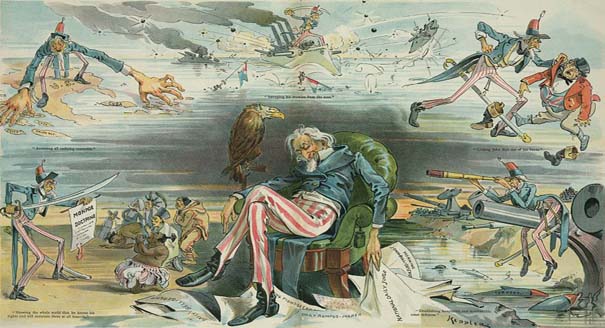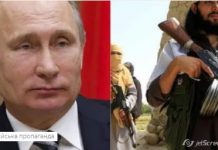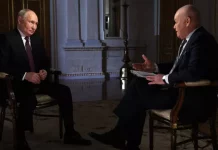
The Levada Center, an independent Moscow-based polling group, has tracked Russian attitudes towards the United States since the early 1990s, with the occasional gaps in the first few years. There have been four bursts of antipathy toward the U.S. during this period: 1998, 2003, 2008, and 2014-2015. Predictably, each of these episodes correlated with the two countries’ disagreements over conflicts in Kosovo, Iraq, Georgia, and Ukraine. Each time, anti-American sentiment grew radically in the course of one or two months, and each time (with the exception of the latest crisis) relations between the two countries normalized just as quickly. These dynamics are easily explained by the propaganda on Russian television: when anti-American rhetoric came into full force, the number of those expressing antipathy toward the U.S. in opinion polls surged; when the rhetoric became less intense, so did negative feelings about America. However, understanding why Russian public opinion of the U.S. is so easily influenced by propaganda requires a deeper analysis of these fluctuations.
During this brief period, the U.S. was perceived not just as a point of reference but as Russia’s most reliable partner, one that could be counted on for support. 37% of survey participants named the U.S. as the first country they would expect to step in and help in a crisis, compared to 9% who felt that way about Germany. 44% of respondents were confident that the U.S. would provide assistance if necessary—only 18% said they did not expect such assistance, with the remainder saying they could not answer the question or did not seek assistance. America was seen primarily as a friendly country (51%) or an ally (16%), with only 1-2% perceiving it as hostile to Russia.
In 1992, Russian citizens saw cooperation with the U.S. as an even greater priority than cooperation with the neighboring Commonwealth of Independent States (CIS) – 38% vs. 25%. In light of those numbers, an American-centric policy on the part of former Russian President Boris Yeltsin and then-Foreign Minister Andrei Kozyrev made a lot of sense. However, by the end of 1993 Russia’s priorities had changed and only 35% of people said they looked toward the U.S., while 45% wanted to focus on the CIS. The deepening economic crisis made it clear that for Russia, the level of development seen in the U.S. was out of reach for the foreseeable future. Enchantment gave way to disappointment: the Russian public had sour grapes about an American standard of living that they could not hope to achieve.
Today it seems obvious how futile it was to hope that Russia, as the loser of the Cold War out of sync with Western economic and political standards, would be welcomed into the international community with open arms. Certain things, like the lengthy talks on WTO accession or the reluctance of the U.S. to repeal the Jackson-Vanik amendment, must have seemed particularly frustrating (albeit for the elite rather than for the general public). Integration, negotiations, and trust-building were unavoidably lengthy and painful processes. But back then nobody wanted to wait, and so hope quickly gave way to disillusionment and indignation. The roots of anti-Americanism stretch back to this problem, and to the traumatic experience of a rapid transition that the majority of the population could not understand: Russia went from being a superpower to being a junior partner that is constantly playing catch-up and has a lot to learn before it can be treated as an equal.
The Birth of a New Model
Polls conducted over the next few years show that overall, Russian attitudes towards the U.S. began to change. The U.S. bombing of Iraq in 1993 was the first major challenge to pro-American sentiment. Public opinion was split: a third of survey respondents were in favor of U.S. actions, but half were opposed, including 26% who “strongly condemned” the strikes. It is difficult to say which sentiment was stronger: opposition to the war, or resentment that major decisions in the world were now being made without taking Russia’s opinion into account.
Nevertheless, in 1995-1996 most Russians interpreted U.S. actions towards their country as benevolent. Only 7% viewed the U.S. as an enemy, compared to the current 62%. By that time Washington was no longer an “ally,” but it still came in sixth on the list of “enemies” listed by those polled—after the mafia, corrupt bureaucrats, Chechens, and others. Today the U.S. is number one on that list. In 1997, half of the Russian population believed that Russia and the West were foreign policy adversaries, while only 30% saw them as allies. At the same time, only a third perceived the U.S. as a threat to world security—something that soon changed dramatically.
The events of 1998-1999 were critical for Russian attitudes toward the U.S. This period marked a series of events that strained bilateral relations: the U.S. military operation in Iraq, the NATO intervention in Yugoslavia, the start of the Second Chechen War and the West’s subsequent criticism of Russia, the U.S. withdrawal from the ABM Treaty, and the first eastward expansion of NATO since the collapse of the Soviet Union.
The framework with which many Russians interpreted later international conflicts with the U.S. appears to have emerged at this time. Half or more of the respondents believed that U.S. actions in each conflict were motivated exclusively by a desire to establish control over the territory in question rather than to ensure compliance with international law or punish those who violated it. The same proportion of survey participants attributed the Kosovo, Iraq, and later conflicts to U.S. interests. Russians’ perception of NATO interventions in Afghanistan and Iraq, as well as of events in Libya and Syria, follow the same pattern.
There were significant consequences, too, of the outburst of enthusiasm among large segments of the public and the elite about the actions of Russian servicemen in Kosovo (though journalists who covered the conflict did not consider these actions to have tangibly benefited the Serbs). Russia’s deployment of troops to Pristina Airport sparked great optimism back home—the appeal to patriotic sentiment through the use of foreign policy as a way to bolster the government’s legitimacy thereafter became the signature tactic of Russia’s next administration.
The 1999 announcement of the U.S. withdrawal from the ABM Treaty and NATO’s expansion also reinforced the Russian public’s certainty that America was acting maliciously. Surveys showed that 55% of the population believed the U.S. position on the ABM Treaty to be against Russia’s interests. Almost the same percentage (50%) felt that Russia should respond to NATO expansion by increasing its security and defense capacities (23% wanted to develop cooperation and 13% saw no need to react). Around the same time, the U.S. first took its place at the number one spot on Russians’ list of countries that “pose a risk to Russia’s security”: 23% held this opinion in 1998, and 35% in 1999.
75% of Russians agreed with the statement that “the U.S. is taking advantage of Russia’s troubles to turn it into a second-class country,” and 60% were confident that the U.S. wanted Russia to break into several parts, but only 8-9% considered a military conflict between the U.S. and Russia to be a serious possibility. By the time Vladimir Putin became president in the early 2000, the perception of the U.S. in Russia was already close to what it is now, even without the aid of daily television propaganda that we attribute it to.
One more development that the Russian government responded to in 1999 was Western criticism of Russia’s actions in Chechnya. For the first time, the Kremlin openly accused the West of supporting terrorists. It also revived the propaganda technique of blaming the West for Russia’s misfortunes.
The Final Transition
This approach was effective. In 2008, half the population believed the main cause of the war with Georgia was the U.S.’s desire to “extend its influence to Russia’s neighbors”; another 32% blamed Georgia, and only 5% considered Russia responsible. This demonstrates another common reaction to the collapse of the Soviet Union: an unwillingness to respect the agency of former Soviet republics and a refusal to acknowledge that some of them might choose to follow a Western model rather than a Russian one. This pattern can be observed in the situation with Georgia, with NATO accession, and mostly recently with Ukraine.
Before turning to the most recent chapter in U.S.-Russian relations, it’s important to say a few words about the several unsuccessful “reset” periods. There was a chance to alter the situation after the September 11th attacks, which changed the minds of many of Russians. The Russian public then saw cooperation between Putin and U.S. President George W. Bush as a sign that Russia was regaining its foreign policy influence, and considered the “joint fight against international terrorism” the main factor bringing the two countries closer (51% of respondents in 2002). At the same time, Russians were already fairly set in their perception of the U.S. as a global hegemon. According to respondents to this survey, the main factors driving the two countries apart were “the arrogance of Americans towards other people” (38%), “the desire of top U.S. officials to expand their influence” (36%), and “U.S. unwillingness to take the interests of other countries into account” (32%).
The final rift in relations can be pegged to 2003-2004, a period that corresponds with America’s invasion of Iraq, a series of “color revolutions” that the Russian elite interpreted as a conspiracy against Russia (interestingly, only a fifth of the general public held this view), and a second phase of eastward NATO expansion. Since that period, polls show a trend of increasing Russian isolation from the U.S. and NATO, against a backdrop of talk of Russia’s “special path.” In 2002, half the population was in favor of cooperating with NATO and a quarter was opposed; a decade later the breakdown reversed. In the mid-2000s, the U.S. and NATO rose to the top of the list of “Russia’s enemies” and the U.S. was listed among those states “most hostile towards Russia.”
Beyond Propaganda
Several factors have contributed to today’s record anti-Americanism (81% of respondents expressed a negative attitude toward the U.S. in January 2015). Above all, ever since demonstrations in favor of EU integration (the so-called Euromaidan) began in Ukraine in November 2013, Russian television channels have been perfecting a propaganda model that implies the protests are part of a U.S. conspiracy against Russia. Half of survey respondents believe that the main driving force of the protests in Kyiv was “the influence of the West, which is trying to draw Ukraine into its political orbit.” This opinion has become increasingly popular, growing from 41% of respondents in December 2013 to 54% in December 2014. A majority of Russians (56%) think that the conflict in east Ukraine continues because it is “advantageous for the government of the United States and other Western countries,” not because Russia is taking part in it (6%).
With the memory of the Orange Revolution still fresh, the Kremlin most likely sought to portray Euromaidan as an American project in order to discredit public protest sentiment as quickly as possible, since Russian and Ukrainian surveys conducted at the rallies showed it to be similar in origin to the Moscow-based protest movement of 2011-2012. Russian authorities did not want a successful spin-off of the civil protest to emerge on Russian soil. And so as events unfolded, the Russian media amplified the idea that the demonstrations were the product of American sponsorship.
But it would be an oversimplification to say that the resulting attitudes in Russia were the product of propaganda alone. About 30% of Russians nationwide have access to alternative sources of information. In Moscow and other major cities this figure is twice as high (approximately 60%), and yet Putin’s Ukraine policies are only slightly less popular in urban areas than they are nationwide. Alternative information exists, but most Russians refuse to take it into consideration. This sentiment is most fully articulated in responses to the question of whether there are Russian troops in Ukraine: 37% are confident that there are none, while another 38% say that “even if there are Russian troops, Russia’s best option in view of current international conditions is to deny such facts.”
The annexation of Crimea, the inability of the West and the U.S. to do anything about it, and a sanctions war, gave a majority of Russians the sense for the first time since the collapse of the Soviet Union that their country was a superpower (70% of respondents feel this way, compared to just 47% in 2011). This represents a certain retribution for their defeat in the Cold War, and compensation for Russia’s inability to catch up with the U.S. in living standards. Participants of a special focus group used phrases such as “they’re paying attention to us again,” “we bared our teeth,” and “they will have to reckon with us.” Government approval ratings demonstrate that all of this brings people a great deal of satisfaction. One respondent said that “while previously Putin could only talk about Russia’s greatness, now his actions have proven it” – not only to [Russians], but also to the U.S.
To summarize, Russian anti-Americanism is rooted in the demise of groundless, unrealistic hopes in the 1990s—specifically, the hope that the new Russia would be unconditionally accepted into the core of the world’s leading states despite failing to meet Western political and economic standards. The realization that Russia would not quickly reach American living standards also played a role. Finally, U.S. military actions in Iraq, Kosovo, and Afghanistan, were interpreted as “hostile” actions toward Russia and contributed to a downward slide in public opinion.
At the same time, throughout the 1990s anti-Americanism was largely situational, and U.S. policy was considered to be aggressive, but not targeted at Russia specifically. The events of 1998-1999 and 2003-2004 prompted most Russians to view U.S. actions as a threat to their own security, and then to support a policy of isolationism. The Russian government had noticed back in the late 1990s that challenging the U.S. had a positive effect on approval ratings, so by the mid-2000s the Kremlin made anti-Americanism a key component of its propaganda campaign. In recent years, the standoff with the U.S. has been one of the main tools in the Russian authorities’ efforts to maintain their own legitimacy in conditions of economic crisis.
By Denis Volkov – sociologist, expert of the Levada Center, for Carnegie Moscow Center





